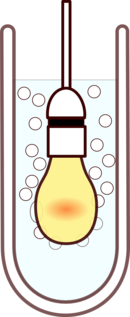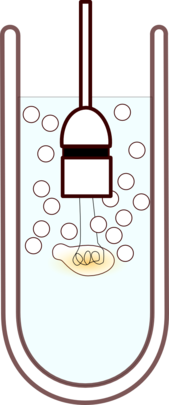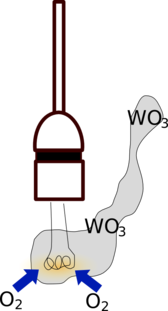Light Bulbs in Liquid Nitrogen
Ingredients
When
Dr Hal came to visit us he brought a lovely exeriment along. First he put a lit light bulb in liquid nitrogen and then a bare filament.
Explanation
 When the whole light bulb is put in the liquid nitrogen the surfaces in contact with the nitrogen will of course cool down to close to -196°C but the filament is insulated by the glass envelope and the very low pressure argon gas inside.
When the whole light bulb is put in the liquid nitrogen the surfaces in contact with the nitrogen will of course cool down to close to -196°C but the filament is insulated by the glass envelope and the very low pressure argon gas inside.
Liquid nitrogen is non conductive so having the electrical contacts surrounded with liquid nitrogen is no more dangerous than the gaseous nitrogen, which they are normally surrounded by in the air.
So when the power is turned on the filament can heat up to white heat as normal and glow as you would expect in the open air.
What is more surprising is that the filament still lights up when it is directly in the liquid nitrogen. This is because conventional light bulbs produce a huge amount of heat energy. This goes into evaporating the liquid nitrogen which forms an insulating bubble around the filament, allowing it to heat up and glow.
Nitrogen is very unreactive so despite the fact that the filament is at about 2000°C the nitrogen doesn't react with it. However, if the filament is taken out into the open air it reacts very quickly with the oxygen surrounding it to form tungsten trioxide (WO3), which forms the cloud of smoke around it and the filament rapidly breaks and dies.
 |  |
|---|---|
| The filament causes liquid nitrogen to boil producing an insulating bubble of nitrogen around the filament | If the filament is in the air oxygen can get to the filament reacting to form tungsten oxides and it burns away. |









Comments
Add a comment